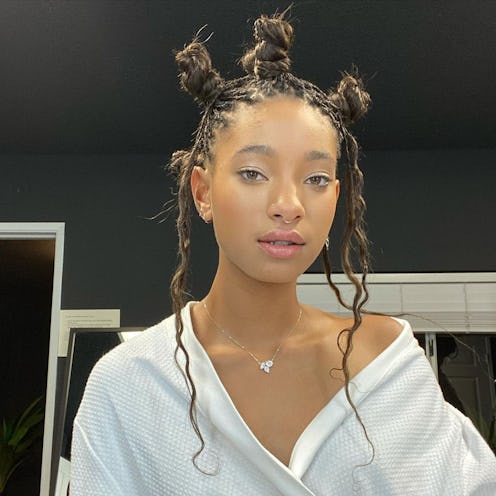(Hair)
There’s A Celeb-Approved Bantu Knot Style For Every Look & Aesthetic
Get knotty.

Few hairstyles of any sort are as instantly recognizable and stylistically distinct as Bantu Knots. Intricate, customizable, and highly protective, it’s no wonder perennially chic celebrities like Lizzo, Yara Shahidi, Rihanna, Zoë Kravitz, Issa Rae, Jodie Turner-Smith, and Beyoncé all keep the style in their regular red carpet (and real-life) rotations. But to fully appreciate the power of Bantu Knots you have to understand its long, rich history and the significance the style holds in the world of natural hair. Bantu knots are more than a popular hairstyle — they’re a cultural statement and celebration all in one. Ahead, TZR explores the Bantu knot tradition and how to get the style yourself.
What Are Bantu Knots?
Bantu knots, occasionally referred to as Zulu Knots or Nubian Knots, are a protective hairstyle consisting of neatly sectioned two-strand twists wrapped around themselves to form those distinctive protruding mini-buns, or knots. They originated with the Zulu people who migrated from eastern Africa to southern Africa, where they make up the largest ethnic population in South Africa to this day. Protective hairstyles shield delicate natural hair from the elements and hazards of everyday life by tucking the hair into buns, twists, braids, locs, and other shielding styles — and Bantu knots are among the most popular.
Bantu knots boast serious versatility, too. Along with the classic two-strand twist, they can be formed with your own braids, locs, with feed-ins and extensions, and can be placed in any order or pattern you like (just be mindful of sleep comfort if you’re leaving them in overnight). Do several small knots, a crown of larger ones, pull all your hair up, or leave it partially down for movement and length.
How To Prep Hair For Bantu Knots
Though they look so detailed and complex, part of the fun of Bantu knots is how DIY-friendly they are. Erinn Courtney, stylist and natural hair care professional, confirms that this is one protective style that can easily be done at home without the help of a pro — but there are several steps before, during, and after styling that can make your Bantu knots look better, feel comfortable, and last longer.
Before you get started with sectioning, stretching, or twisting, the first thing to do is assess if Bantu Knots are right for you. While Courtney tells TZR that the exact minimum length for Bantu Knots is largely dependent on the skill and nimbleness of the stylist (or you, as the case may be), roughly four to five inches of hair is all that’s required. After planning out your creative strategy, it’s time to prep the hair. Courtney advises blow-drying hair with light tension to stretch it out for maximum length, but take care to layer on some heat protectant first to minimize damage as well as smooth flyaways and frizz. If you prefer a looser, curlier Bantu knot style then just proceed to section loosely (like below) on cleansed, conditioned hair.
How To Style Bantu Knots
For classic all-over Bantu knots, Courtney instructs to part and divide hair into approximately eight to 10 sections. The part shape and placement (as well as the number of knots) are ultimately up to you. The hairstylist recommends using small rubber bands to keep every section together and out of the way while you work. Split those patches into two even strands and start twisting them around each other — this is the best method for keeping hair tangle and snag-free. From there, simply wind your completed twist up into a bun and either tuck the ends in or secure the entire knot with a small, clear elastic.
Bantu Knots Aftercare
Thanks to their surprising simplicity, Bantu knots can be worn for a few hours or a few days depending on how they hold up and, of course, your personal preference. “Bantu knots last about seven to 10 days with proper care and upkeep,” Courtney tells TZR, which includes sleeping with a silk scarf, bonnet, or pillowcase. “Edge control is a great product to use when doing Bantu knots because it keeps the hair from frizzing while in the style,” she adds. “It can also help make the parts of the style crisp and defined, making it look better for longer.”
No matter how you choose to style your Bantu knots (or dress them up — hair rings are here), prepare for all the Main Character moments that await. With this style, it’s just an inevitability.